The main difference between gyuto and santoku knives is that gyuto is traditionally used for cutting meat, such as beef chunks, while santoku is a vegetable knife. In appearance, gyuto has a longer blade with a pointed tip, while santoku has a shorter blade with a rounded tip.
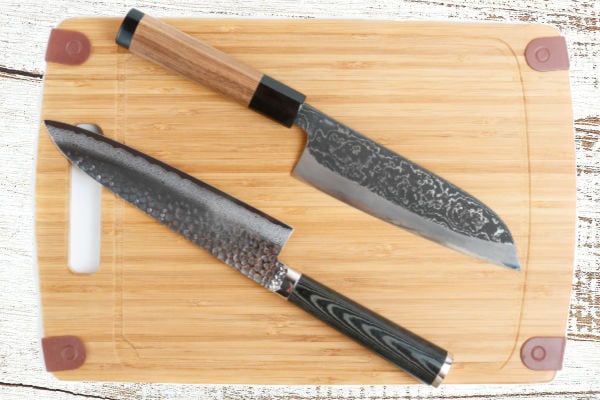
While you can use both knives for different cutting and chopping needs, they have differences that matter. If you've come to this page, you may be trying to determine whether you should invest in a gyuto or santoku knife.
This article will discuss the differences between these knives and their features, strengths, and weaknesses.
Gyuto vs. Santoku Comparison
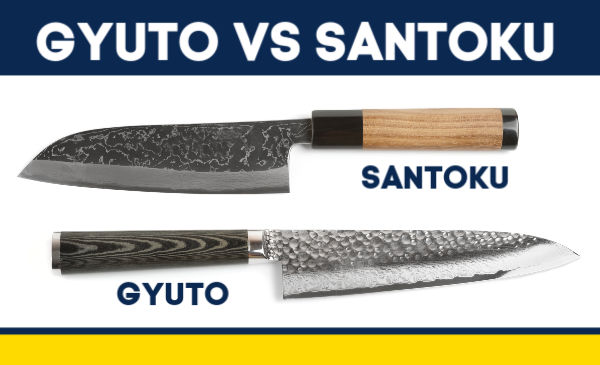
The santoku and gyuto are both versatile Japanese knives to have in the kitchen. Whether you need them for commercial or at-home use, they'll take care of 90% of your food preparation.
You will find that a gyuto is capable of performing any task that the santoku can. But, it also has a pointed tip, which is useful for getting into tight spaces. This knife also allows the user to rock slice thanks to its curved blade.
| Gyuto | Santoku | |
|---|---|---|
| Best use | Chopping, dicing, mincing. A Good all-rounder. | Chopping, dicing, mincing. A Good all-rounder. |
| Weight | Heavier | Lighter |
| Blade sharpening skill | Intermediate | Intermediate |
| Blade shape | Up to 14" long, slightly curved blade with pointed tip. | Usually 5-7", sheep's foot blade with rounded tip. |
| Bevel | Double bevel, thin but sturdy. | Double or single bevel. |
| Price | Mid to high Range | Mid Range |
The Benefits Both Knives Share
- Allrounders: useful for 90% of jobs in the kitchen.
- Sharpness: slice through meat, fish and vegetables with ease.
- Clean cuts: no more pieces of vegetable stuck together by threads (think celery!).
- Precision: make accurate thin slices that bring a dish to life.
Both knives a good multi purpose knives so does it even matter which one you choose? Absolutely. Let’s look at each knife in more detail.
Related post:
You may also be interested in our comparison of the usuba and nakiri knife. We provide an in-depth look at two Japanese knives designed for chopping vegetables quickly.
Gyuto
Loosely translated, Gyuto means "cow sword." It was given this name because the original use for this knife was cutting large cuts of beef. A gyuto will take care of most of the chopping, slicing, and dicing you'll perform in the kitchen. Although they can be very long, the standard size is around 10 to 12 inches.
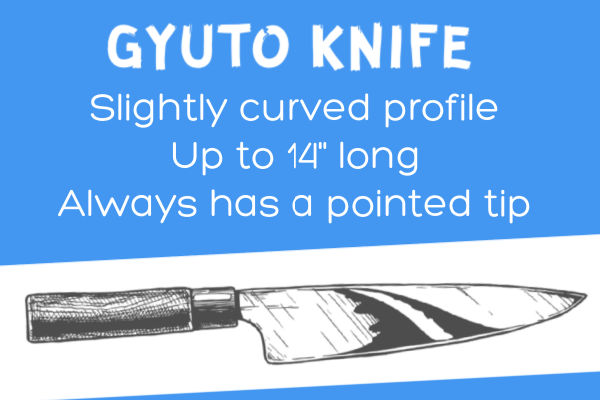
Benefits a Gyuto Offers Over a Santoku
- Its length makes chopping larger items like cabbage easier
- a thinner, harder blade
- A curved blade allows for rock chopping
- A pointy tip assists with getting into hard to reach places
Santoku (Bukabocho)
The Santoku is another multi-purpose knife that will take care of most jobs in the kitchen. So how did this knife begin? In the 1940s, the Japanese took their nakiri (a type of meat cleaver) knife and gave it similar features to the Western chef's knife. The reason was to make it a more suitable tool for the home kitchen.
Translated, it means "knife of three virtues," which refers to its suitability for slicing, mincing, and dicing. Others believe the three virtues are processing meat, fish, and vegetables. Either way, you get the picture – this knife has many uses.
An essential feature of the Santoku is its flat blade profile. For those that prefer chopping straight through vegetables in one cut rather than rock cutting, this is a good choice.
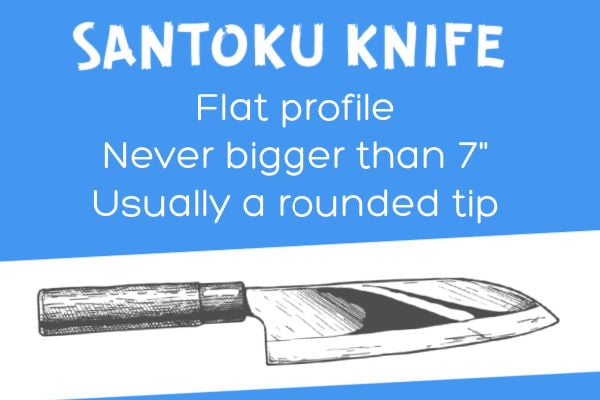
Features of a Santoku Knife
- Benefits a santoku offers over a gyuto
- A shorter length knife will appeal to some cooks
- Safer, more practical option in very confined, busy cooking spaces
- Flat blade makes it easier to make clean cuts with vegetables
- Tend to be more affordable than a similar gyuto
- Scrape ingredients off the chopping board using the flat blade
The Santoku is a compact, lightweight knife that has exceptional balance and feels great in the hand. This cutting tool would be ideal for the smaller chef who doesn't like wielding a large blade in the kitchen.
Which is the best option?
Does size matter?
If you're happy using a long blade, then the gyuto is an excellent option. It makes easy work of oversized vegetables with one simple chop. But not everyone likes a large edge – if that's you then a more compact, balances santoku would be a wise choice. This is a knife you'll use frequently, so it needs to be super comfortable in your hand.
What is your budget?
Knife enthusiasts will be likely to have both knives in their set. If budget isn't a big issue, then this may be an option for you too as they'll both come in handy for different jobs. Over time, you'll find that each knife will have its use. I'd guess that, for most, the gyuto will be the preferred option for most tasks.
If your budget only allows for the most affordable option, you'll find a santoku that will save you a few dollars upfront. Both knives vary in price, but if you were to compare these two knives, both of a similar size and quality, the gyuto would usually cost more.
What's your chopping style?
If you're a "rock-chopper," the gyuto, or chef's knife, is the better option thanks to its curved blade. Although it's a bigger knife, you'll be surprised at how intricate the cuts can be. Batonnet, allumette, and jardiniere cutting styles are all possible.
The Santoku is capable of the above cuts, as well. Its flat blade makes easy work of chopping onions, leeks, celery, and herbs.
Are you a scraper?
There are times when you'll be in a rush while cooking. Guests are over or you need to get the kids to a friend's house. You could work in a commercial kitchen, which means you're always in a hurry! The Santoku has a flat blade, which allow the user to easily scrape chopped vegetables into a pan. This feature may not sound important, but it's little things like this that can save a lot of time over a whole year of cooking. The curved gyuto blade makes scraping a little messy. It usually requires a second or third attempt to get everything into the pan.
The Common Parts of a Knife
Let's take a quick look at the components of a knife. Whether you're a chef or an at-home cook, understanding knife terminology will always be useful. Although it's not essential to know all these different parts of the knife, it does help when you're looking to buy a new kitchen knife. You'll frequently hear knife experts referring to terms like spine, heel, and handle. I recommend taking a minute to digest them.
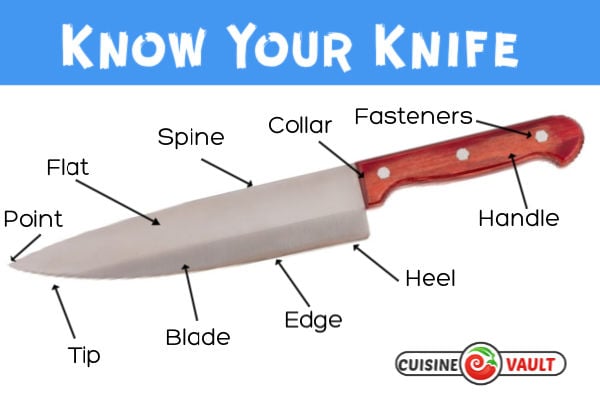
Quick Tip
Both knives in this review are worth adding to your knife set. When picking a good option to buy, most people will look at the blade. It's essential to look closely at the handle as well. Comfort and safety are both important considerations. Look for a handle that is riveted or molded into the blade. It'll keep the blade secure and prevent it from slipping out.

Your knife will last several years, so consider the handle's appearance also. Materials such as hickory, ebony, pakkawood, or stainless steel will look impressive and feel comfortable in the hand.
Final Words
When comparing the gyuto and santoku, you'll find they are both very capable Japanese knives that'll take care of 90% of your cutting needs. Their differences are quite subtle. Choosing the best option for your needs will come down to personal preference. At a push, I'd choose the Gyuto thanks to its curved blade and pointed tip. Also, its length makes easy work of larger cutting jobs.
These knives are not designed for heavy-duty chopping. Don't buy one of these to chop through bones.
Whichever knife you choose, keep in mind that maintenance is required. Invest in a whetstone to keep your knife sharp. otherwise, be prepared to get an expert to sharpen your knife frequently. A blunt knife is frustrating to use and can be dangerous in the kitchen.
You can check out the latest knives on Amazon here:
Gyuto knives>
Santoku knives>
What's your preferred all-around knife in the kitchen? Do you prefer to carry the whole set so that there's no need to choose a winner? Let us know in the comments below.

Leave a Reply